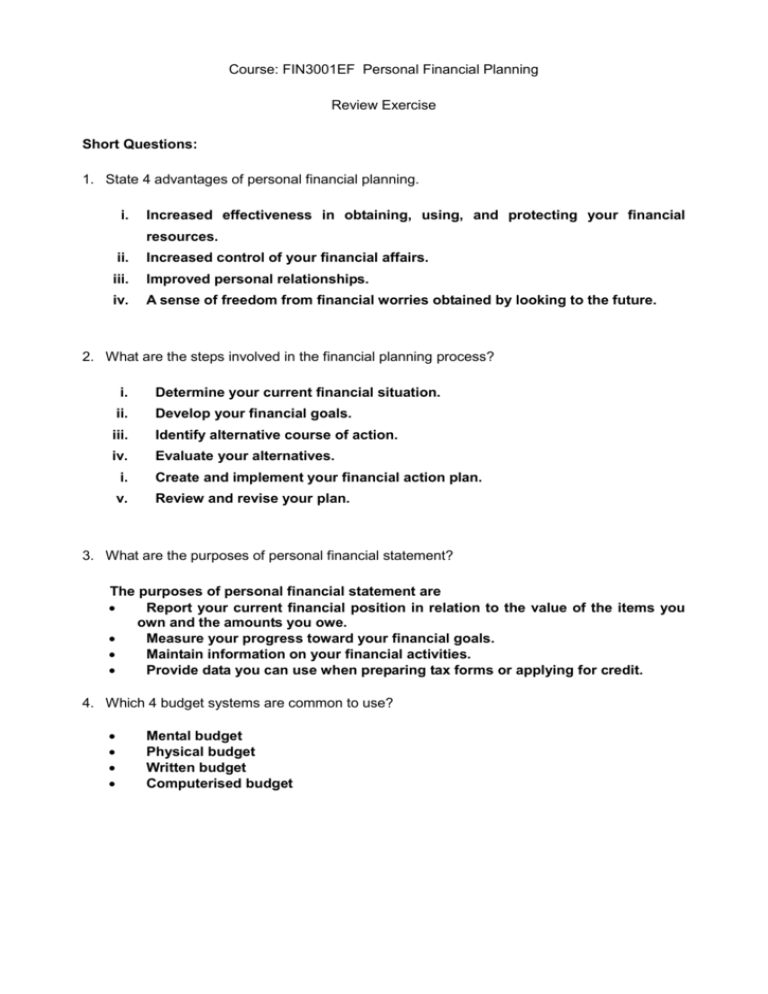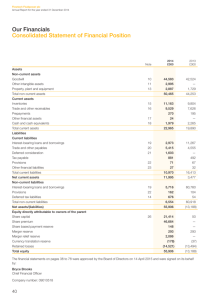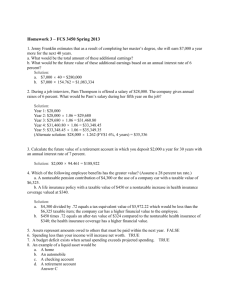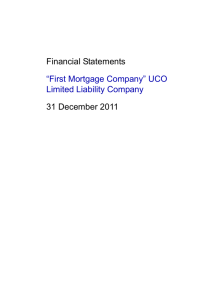Document
advertisement

Course: FIN3001EF Personal Financial Planning Review Exercise Short Questions: 1. State 4 advantages of personal financial planning. i. Increased effectiveness in obtaining, using, and protecting your financial resources. ii. Increased control of your financial affairs. iii. Improved personal relationships. iv. A sense of freedom from financial worries obtained by looking to the future. 2. What are the steps involved in the financial planning process? i. Determine your current financial situation. ii. Develop your financial goals. iii. Identify alternative course of action. iv. Evaluate your alternatives. i. Create and implement your financial action plan. v. Review and revise your plan. 3. What are the purposes of personal financial statement? The purposes of personal financial statement are Report your current financial position in relation to the value of the items you own and the amounts you owe. Measure your progress toward your financial goals. Maintain information on your financial activities. Provide data you can use when preparing tax forms or applying for credit. 4. Which 4 budget systems are common to use? Mental budget Physical budget Written budget Computerised budget 5. What are the two basic types of credit? Give an example for each. Two basic types of consumer credit are closed-end and open-end credit. With closed-end credit, one-time loans that the borrower pays back in a specified period of time and in payments of equal amounts. With open-end credit, a line of credit in which loans are made on a continuous basis and the borrower is billed periodically for at least partial payment. Examples for closed-end credit: mortgage loans, automobile loans, and installment loans. Examples for open-end credit: overdraft protection, credit cards, revolving cheque credits. 6. What is consumer credit? Credit is an arrangement to receive cash, goods or services now, and pay for them in the future. Consumer credit is the use of credit for personal needs except a home mortgage , by individual and families. 7. What are the Five Cs of Credit? i. Character ii. Capacity iii. Capital iv. Collateral v. Conditions 8. What are the danger signals to show you are in debt problems ? Paying only the minimum balance each month. Increasing the total balance due each month. Missing or alternating payments or paying late. Intentionally using overdraft protection or taking frequent cash advances. Using savings to pay routine bills such as food. Getting second or third payment notices. Not talking to your partner about money or talking only about money. Depending on overtime to meet routine expenses. 9. State 4 types of health care coverages? Hospital expenses insurance. Surgical expense insurance. Physician expense insurance. Major medical expense insurance. Comprehensive major medical insurance. Dread disease and cancer insurance policies. Hospital indemnity. Dental expense insurance. Vision care. Long term care insurance. 10. What is the whole life policy and one of policy options given? Whole life policy is also called straight life insurance. Policyholder pays the premium as long as his/her live. The amount of premium depends on your age when you start the policy. The policy provides death benefits and accumulates a cash value. The policyholder can borrow against the cash value or draw it out at retirement. e.g. limited life policy, variable life policy, adjustable life policy and universal life. 11. What is the definition of life insurance, and the purpose of the life insurance? Life insurance is an insurance company promises to pay a lump sum at the time of the policyholder’s death, or sometimes while they are still alive. Purpose of life insurance is protecting someone who depends on you from financial loss related to your death. 12. Explain what role(s) are you playing in the investment process? As an investor the role should be most important in the investment process, namely evaluate potential investments, seek the assistance of a financial planner, monitor the value of the investments, keep accurate and current records, and consider the tax consequences of selling investments. 13. What is the difference between straight-life annuity and joint-and-survivor annuity? Straight-life annuity provides more income than any other type, but payments stop when you die. Joint-and-survivor annuity pays until the last survivor you designate dies. 14. What are the ways to manage risk? There are 4 ways to manage the risk, namely risk avoidance, risk reduction, risk assumption, and risk shifting. 15. What are the 5 components of risk factor? Inflation risk Interest rate risk Business failure risk Market risk Global investment risk 16. What is the difference between Pure Risk and Speculative Risk? Pure Risk is a risk which is insurable. There is chance of loss and no gain. The incident is happened accidentally and unintentional. Nature and financial loss of the risk can be predicated. Speculative Risk is a risk which is uninsurable. There is chance of loss or gain such as starting a business. 17. How does tax avoidance differ from tax evasion? Tax avoidance refers to the use of legitimate methods to reduce one’s tax evasion is taxes. Tax evasion is the use of illegal actions to reduce taxes. 18. What are the characters of taxation system in Hong Kong? Schedular Tax System which is charging separately for 3 different types of income under 3 headings: salaries tax, property tax and profits tax Simplicity – direct and indirect tax Territorial source concept – only income derived from Hong Kong is taxable. Low tax rate Year of assessment – between 1st April of the current year and 31st March of the next year. Provisional tax assessment system – required to pay provisional tax for the next year in advance. Forms of assessment – separate assessment, joint assessment, and personal assessment. 19. What is the different between the guardian and trustee? The guardian will take the responsibility for providing the children with personal care and managing the estate for them. Trustee will manage property for benefit of children. 20. What are the responsibilities of an Executor? Take control of assets of the estate. File an inventory of assets and liabilities with the court. Liquidate assets if necessary to pay claims. Distribute assets based on the instructions in the will. Make a final accounting to the court. Financial Problems: 1. Use the items in the following table to calculate the ratios required: Liabilities Liquid assets Monthly credit payments Monthly savings Net worth Current liabilities Take-home pay Gross income Monthly expenses $12,000 $2,200 $150 $130 $36,000 $550 $900 $1,500 $850 Debt ratio: Liabilities/Net worth = $12,000/$36,000 = 0.3333 Current ratio: Liquid assets/Current Liabilities = $2,200/$550 = 4 Debt-payment ratio: Monthly credit payment/Take-home pay = $150/$900 = 0.1667 Saving ratio: Amount saved per month/Gross monthly income = $130/$1,500 = 0.0867 Liquid ratio: Liquid assets/Monthly expense=$2,200/$850 = 2.5882 2. Use the following items to prepare a balance sheet and a cash flow statement. Determine the total assets, total liabilities, net worth, total cash inflows, and total cash outflows. Rent for the month, $650 Cash in checking account, $450 Spending for food, $345 Current value of automobile, $7,800 Credit card balance, $235 Auto insurance, $230 Stereo equipment, $2,350 Lunches/parking at work, $180 Home computer, $1,500 Clothing purchase, $110 Monthly take-home salary, $1,950 Savings account balance, $1,890 Balance of educational loan, $2,160 Telephone bill paid for month, $65 Loan payment, $80 Household possessions, $3,400 Payment for electricity, $90 Donations to church, $70 Value of stock investment, $860 Restaurant spending, $130 Total assets = $18,250 ($450 + 1,890 + 7,800 + 2,350 + 1,500 + 3,400 + 860) Total liabilities = $2,395 ($235 + $2,160) Net worth = $15,855 ($18,250 - $2,395) Total cash inflows = $1,950 Total cash outflows = $1,950 ($650 + 345 + 230 + 180 + 110 + 65 + 80 + 90 + 70 + 130) 3. Based on the following data, calculate the ratios requested: Net worth $48,000 Take-home pay $2,600 Gross income $2,850 Current liabilities $950 Monthly credit payments $540 Liquid assets $5,200 Liabilities $7,000 Monthly savings $180 i. Debt ratio: 7,000/48,000=0.1458 ii. Current ratio: 5,200/950=5.47 iii. Debt-payment ratio: 540/2,600=0.21 iv. Saving ratio: 180/2,850=0.06 4. Based on the following data, calculate the ratios requested: Long-term liabilities $854,321 Net worth $1,448,000 Liquid assets $55,200 Current liabilities $45,650 Mortgage repayment $84,000 Mortgage loan outstanding $555,234 Credit card repayments $5,540 MPF $12,000 Interest earned on savings $150 Gross income $281,850 Car loan repayment $38,087 Property market value $685,483 i. Debt-payment ratio: (5,540 + 38,087) / (28,1850 + 150 – 12,000) = 0.16 ii. Debt-to-equity ratio: (854,321 + 45,650 – 555,234) / (1,448,000 -685,483) = 0.45 5. What would be the 6-month’s interest earnings for a person who deposits $2,000 monthly in savings at an annual interest rate of 5.5 percent? $2,000(1+5.5%/12)6 +$2,000(1+5.5%/12)5 +$2,000(1+5.5%/12) 4 +$2,000(1+5.5%/12)3 +$2,000(1+5.5%/12)2 +$2,000(1+5.5%/12) = $12,193.98 $12,193.98 - $12,000 = $193.98 6. If a person spends $100 a week on coffee (assume $5,200 a year), what would be the future value of that amount over 3 years if the funds were deposited into his savings account earning interest of 4 percent per annum (interest will be paid twice a year in 6th and 12th month)? $2,600(1+2%)6 +$2,600(1+2%)5 +$2,600(1+2%)4 +$2,600(1+2%)3 +$2,600(1+2%)2 +$2,600(1+2%) = $16,729.14 7. You plan to open a fast food shop after 3 years and $150,000 of capital is required. You decide to deposit a lump sum of money into a time deposit with every 3-month's renewal. The interest rate is 3.5%p.a. How much the lump sum of money does you need to deposit? $150,000/[(1+3.5%/4)12] = $135110.37









